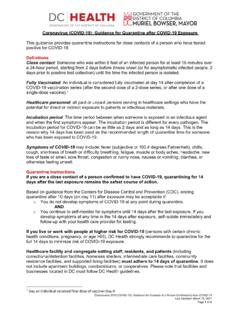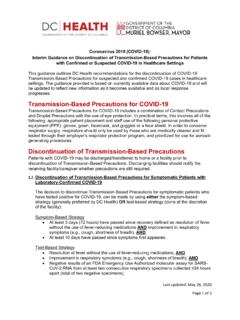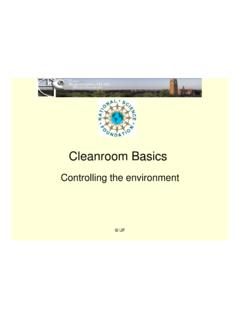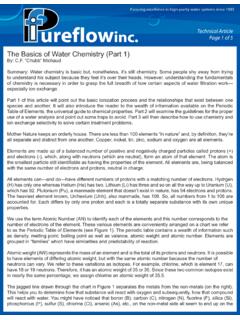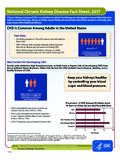Transcription of Indoor mask mandate repealed - coronavirus.dc.gov
1 Mask Guidance for the Public Last updated December 15, 2021 Page 1 of 5 Coronavirus 2019 (COVID-19): Mask Guidance for the General Public This guidance presents current best public health practices for wearing masks that the general public should follow to help prevent the spread of COVID-19. Mask basics : Masks are a powerful tool for preventing the spread of COVID-19. Masks act as a simple barrier to help prevent respiratory droplets from traveling into the air and onto other people when the person wearing the mask talks, coughs, sneezes, or raises their voice.
2 This is called source control. Masks also provide some protection to the mask wearer against droplets expelled by other people. Masks help prevent symptomatic as well as asymptomatic spread of COVID-19. Masks do not cause people to breathe in higher levels of carbon dioxide (CO2). Carbon dioxide is produced when people breathe out. It does not build up behind your mask because: o Masks do not have an airtight seal around your face, and o CO2 is a small molecule that is able to pass through your mask into the air. Indoor mask mandate repealed : DC Mayor s Order 2021-142, which took effect November 22, 2021, discontinued DC s mask mandate for Indoor public spaces.
3 O NOTE: The Indoor mask mandate (regardless of vaccination status or personal history of COVID-19) remains in effect in the following settings: Health care facilities Schools, including Institutions of Higher Education (IHE) 1 Childcare facilities Congregate settings (such as homeless shelters and correctional facilities) Libraries Public transit and ride share vehicles It is not necessary for to wear masks in outdoor areas of a public transportation conveyance (such as the open deck of a ferry, or the open-air upper deck of a double-decker bus.)
4 In any setting when required per workplace or establishment policies NOTE: Businesses and community establishments may maintain stricter Indoor masking policies for patrons and employees at their discretion. o In these settings where the Indoor mask mandate still applies, a mask is not required during the following activities/situations when a person is: actively eating or drinking in a private living space in water ( , in a swimming pool, hot tub, showering) alone in an enclosed office giving a speech, provided that no one is within 6 feet of the speaker teaching a large college or university class with auditorium-style seating, provided that no one is within 6 feet of the instructor speaking to or translating for a deaf or hard of hearing person 1 Roommates in dormitories or other student or staff housing may be considered a household and do not need to wear masks within the household unit ( , dorm room or suite), unless someone is ill.
5 Mask Guidance for the Public Last updated December 15, 2021 Page 2 of 5 required to use equipment for a job that precludes the wearing of a mask and the person is wearing or using that equipment, or when wearing a mask would endanger public safety lawfully asked to remove their mask for facial recognition purposes Mask recommendations: Masks are no longer required in Indoor public spaces. However, wearing a mask is still recommended in many situations. As part of their COVID-19 mitigation plans, many businesses will still require masks to be worn indoors, even by fully vaccinated persons.
6 Wearing a mask indoors when it is not required does not signal that the wearer is unvaccinated or is immunocompromised; the wearer may just be being careful. Recommendations vary by a person s vaccination status: Fully vaccinated people2 Fully vaccinated people are recommended to continue wearing masks in Indoor public settings if community transmission levels are substantial or o They may also choose to wear a mask in Indoor public settings regardless of the level of community transmission if anyone in their household is immunocompromised4 or unvaccinated/not fully vaccinated (including children younger than 5).
7 Fully vaccinated people can participate in outdoor activities safely without masks or social distancing. o Fully vaccinated people may choose to wear a mask in crowded outdoor settings if they or someone in their household is immunocompromised or unvaccinated/not fully vaccinated. o Fully vaccinated people may also choose to wear a mask during outdoor activities if they are in an area with low vaccination rates and substantial to high COVID-19 rates3. Immunocompromised people who are fully vaccinated should follow guidance for people who are not fully vaccinated (see next section), because they may not be fully protected by the vaccine.
8 If a fully vaccinated person has a close contact exposure to a person with confirmed COVID-19, they should wear a mask in Indoor public settings for 14 days after their exposure, or until they have a negative COVID-19 test (performed 5 to 7 days after exposure). o If anyone in their household is immunocompromised or unvaccinated/not fully vaccinated (including children younger than 5), fully vaccinated people may also choose to wear a mask at home for 14 days or until they have a negative COVID-19 test. o For more information about what to do if you are exposed to COVID-19 (for fully vaccinated as well as unvaccinated people), see Guidance for Close Contacts of a Person Confirmed to have COVID-19: Quarantine and Testing at For more information for fully vaccinated people, see Guidance for Fully Vaccinated People at People who are not fully vaccinated or who are immunocompromised Get vaccinated!
9 Find out more about the COVID-19 vaccine at 2 A person is considered fully vaccinated 14 days after they complete a primary COVID-19 vaccine series (after the second dose of a 2-dose series, or after one dose of a single-dose vaccine). The primary series is the standard vaccine course before any extra ( , booster) doses. 3 To look up current levels of community transmission (and other data including local vaccination rates) for DC and other areas of the country, see the CDC Data Tracker at #county-view 4 Immunocompromised means having a weakened immune system due to a medical condition or from taking medications that suppress the immune system.
10 This includes, but is not limited to: people on chemotherapy, people with blood cancers like leukemia, people who have had an organ transplant or stem cell transplant, and people on dialysis. Mask Guidance for the Public Last updated December 15, 2021 Page 3 of 5 People who are not fully vaccinated (including children younger than 5) are at higher risk for catching COVID- 19 and spreading it within their communities. They should continue to wear masks in Indoor public spaces, especially if community transmission levels are substantial or high3.






